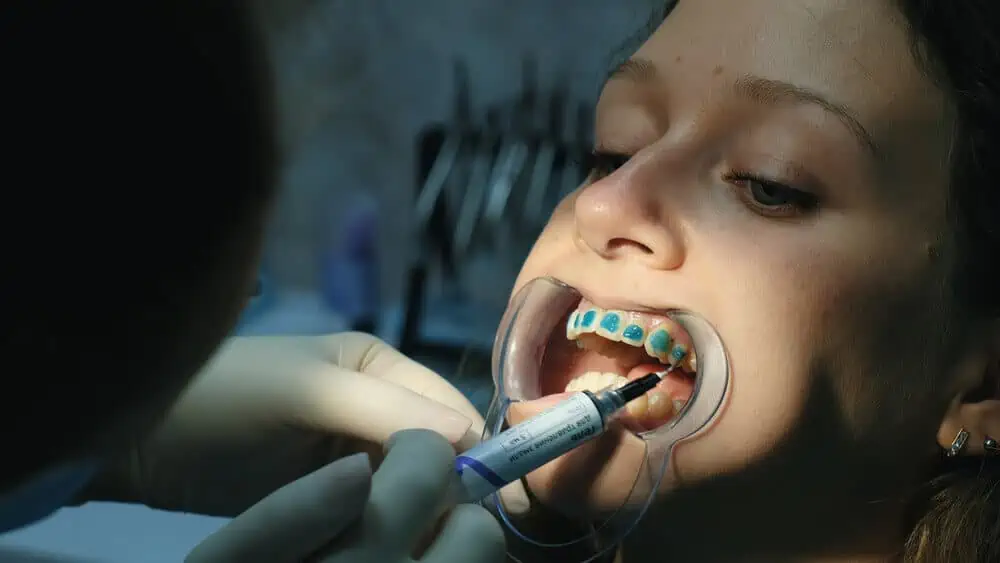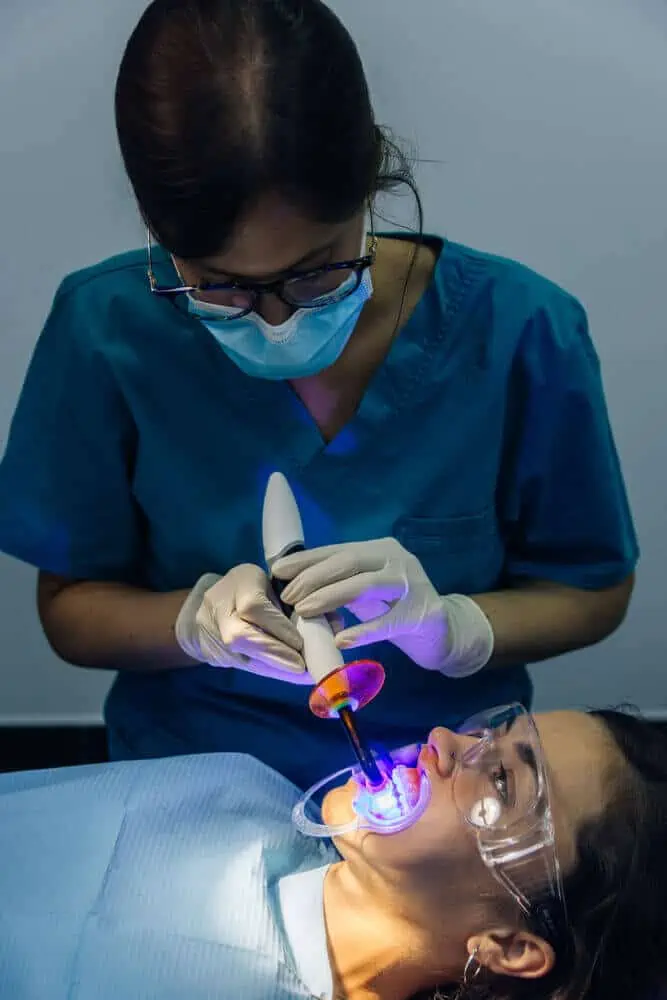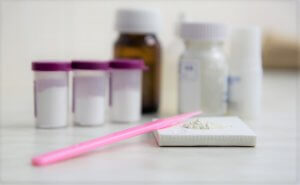It is easy to assume that you are never going to encounter a real dental emergency that requires dental glue. After all, you are doing everything that you can to take good care of your teeth: cleaning them twice a day, being careful of what you bite into, flossing regularly and visiting a dentist every now and then.
However, you might find yourself in a situation where you have a broken tooth or loose crown or filling and require dental restoration. It may be tempting to use regular household glue to try and make the dental repair yourself, but this is definitely not something you should do!
There is actually a special kind of dental glue for teeth, which also goes by the name of dental cement or dental adhesive, used by dentists to help restore broken teeth and prevent further damage.
So what is dental glue? What is it made of and how does it help with temporary and permanent tooth repair? Keep reading to find out!
If you are looking for ways to repair a tooth yourself, our guide to temporary filling kits will help.

Save the trip to your NHS dentist and speak to a certified dentist right now online. Visit JustAnswer to chat online with a qualified dentist and find out all the information you need – without having to take time out for a dental appointment.
Their dentists are based in the US and are available 24/7 to help you out!
What is dental glue?

Dental cement, tooth glue, or whatever you choose to call it, is an agent that a dentist uses for securing a tooth restoration, such as a fixed bridge, inlay, onlay, or crown, to your damaged teeth. Tooth cement can also be used to build up the tooth itself, for example to repair a small chip, and it’s the same stuff that’s used in some types of fillings.
There are various types of dental cement used in the UK – both temporary and permanent – and each material has its own properties which make it suitable different purposes. We’ll discuss these in more detail later.
All types of dental adhesive have one purpose in common: to ensure that your carefully crafted dental restorations or appliances stay exactly where they should be; in your mouth. Plus, in the case of temporary dental cement, it should be easy for the dentist to remove it again when needed.
Let’s take a brief look at how tooth glue actually works.
How does dental cement work?

Dental glue uses retention and resistance upon compression to work as an adhesive. In some types of tooth cements, a formation of chemical bonds also occurs.
For instance, the force exerted by the compressed dental glue lying just beneath the crown of the tooth is what holds and bonds it together. The chemical bond formed between the glue and the crown provides extra strength and it is less likely to break down compared to glue that does not form bonds.
However, because chemically-bonded dental cement is a higher strength, it is harder to remove for repairs or replacement restorations.
Stronger dental cement for crowns is a great option for those who continually grind their teeth as it can provide additional stability and longevity to the crowns.
Permanent vs temporary dental cement
Dental adhesive is classed according to its application:
Type of cement | Application |
Type I(a) | Fine grains used for luting and cementation |
Type I(b) | Medium grain used for orthodontic purposes |
Type II | Used for restorative purposes |
Type III | Used for liners or base applications |
Dental glue for teeth bridges, crowns and other restorations can be further classified according to its durability and composition.
When it comes to durability, dental cements are simply classed as ‘temporary’ or ‘permanent’.
Temporary dental glue
Temporary glue is commonly used to fix crowns and other restorations for a short period of time. A dentist uses temporary crown cement to hold temporary crowns in place, or when they wish to observe and assess how your teeth respond to a particular restoration.
Temporary tooth adhesive is usually made up of eugenol and zinc oxide powder. It has the following properties:
- Provides a good grip on teeth as well as on the crown or other restoration
- Is easily tolerated by the surrounding tissue
- Is easy to remove
- Protects a damaged tooth and helps minimise sensitivity
- Saliva helps it dissolve in a short period of time. Because of this, temporary glue must be replaced with permanent glue in three to six weeks following its application.
Permanent dental glue
Permanent dental glue is the type of teeth glue used for fixing various dental restorations on a permanent basis. It’s made by mixing liquid and powder together to form a paste that has the following properties when it sets:
- Creates a strong bond with the tooth and the restoration to provide long-term, permanent protection
- Is easily tolerated by the surrounding tissue, thereby preventing dead teeth and tissue.
- Provides good sealing at the margins to prevent leakage
- Protects the dental tissue from all sorts of external stimuli
- Provides exceptional resistance
- Does not dissolve in saliva or any other oral liquid; thereby offering permanent protection.
Types of dental glue: composition
Depending on what it’s made of, dental cement can be divided into six types:

Glass ionomer cement
Glass ionomer cement is made from powdered glass mixed with an acid. It is used for the final cementation of bridges and crowns made from alloys, but it doesn’t adhere to porcelain. This type of dental cement is often the material of choice for filling children’s milk teeth.
Bioceramic cement
Bioceramic dental cement is a permanent adhesive agent that appears opaque on x-rays. It’s commonly used for endodontic (root canal) work because it is biocompatible, meaning it can either function as natural tissue or encourage the regeneration of tissue.
Zinc oxide eugenol cement
Zinc oxide cement is an oil-based glue used to soothe the pulp of a broken tooth. It is usually avoided in cases where permanency is required. This cement is particularly helpful to temporarily cement a tooth with exposed dentine. Nowadays, many companies add different splinting agents to the zinc oxide cement to grant it permanent luting effects.
Zinc oxide eugenol is not considered to be a strong product for cementing most types of dental restorations, and its use is normally limited to gluing stainless steel crowns, acrylic crowns, and cast restorations.
Zinc phosphate cement
Zinc phosphate cement was one of the first permanent cements to be used in dentistry, and it remains in wide use today for a variety of permanent restoration purposes. Although it doesn’t chemically bond to the tooth surface, it has exhibited significant long-term success. However, it is gradually becoming less popular because its relatively high acidity can irritate tooth pulp.
Adhesive resin cement
Adhesive resin cement is a permanent dental glue that bonds with most ceramic and alloy restorations, except implant-supported crowns, veneers, indirect resin restorations and bridges.
Aesthetic resin cement
Aesthetic resin cement contains translucent resins that are available in different shades, meaning it can be made to match the natural tooth colour. It is normally used for bonding all-ceramic and indirect composite restorations, including chipped tooth repair. This type of glue has high resistance and utility and a unique composition that does not break apart or dissolve.
How do dentists choose dental glue?
Normally, dentists decide on the kind of dental cement they use depending on the following three factors:
Longevity
Longevity is one of the main factors that the dentist will consider when choosing the best glue for you. They will use a temporary or a permanent glue depending on how long the restoration needs to last.
Durability
Durability really matters when it comes to choosing the right kind of teeth glue, and it basically depends on the type of restoration used. Permanent dental glue provides good durability and is used for keeping long-term crowns and bridges in place. The material that the restoration is made from may also determine the strength and durability needed from the cement.
Aesthetics
Dentists may choose which dental cement to use depending on the aesthetic preferences of their clients. For example, if colour is important, a dentist may choose a resin adhesive. Although, this type of glue is difficult to remove and may get discoloured easily. It is important to keep these factors in mind when deciding on the right type of dental glue.

Application techniques
There are a number of steps that dentists usually follow in order to apply dental cement. In this scenario, we will discuss its application in reference to a tooth crown.
- The mouth is properly cleaned followed by cleaning and disinfection of the crowns. The dentist usually puts a rubber dam or cotton rolls in the mouth to get rid of any fluid.
- The cement is prepared according to the instructions until the desired consistency is achieved.
- The dental crown glue is then applied to the interior of the crown in such a way that it covers it completely.
- The dentist then places the crown on the abutment of the tooth in order to prevent any misplacement.
- After the restoration process is completed, all extra glue is cleared away.
After the process, the dentist will advise the patient when it is safe to eat and how to care for their new crown properly.
Can you use superglue on teeth?
‘Superglue’ is the commercial name for cyanoacrylate adhesives meant for household and medical purposes. This type of adhesive is not meant for internal use, so don’t use super glue as dental glue. Some people may even have an asthmatic or skin reaction as soon as they come in contact with this adhesive.
Superglue may also have a serious reaction with different types of natural fibres, for example, cotton, which is commonly used in dental procedures. These reactions exacerbate the release of toxic fumes and may even lead to combustion.
Furthermore, superglue can form instant bonds with your skin. You could easily end up with your restoration glued to your own finger, or your finger to your tooth, lips, tongue, or cheeks while trying to fix your broken tooth!
If you need to fix a broken tooth or crown in an emergency, you can buy a temporary filling kit that is designed for this purpose. But, you should still visit a dentist as soon as possible to have the problem treated correctly.
Similarly, you shouldn’t use superglue to repair dentures or to try to keep them in your mouth. There are many effective denture fixatives to choose from, which are designed for this purpose.
Conclusion
Dental glue is an amazing creation designed to hold your damaged tooth together, apply restorations, and prolong the life of your tooth. It can provide both short-term and long-term benefits, but must only be used under the supervision of your dentist.
After any procedure involving dental adhesive to repair your teeth, take extra care regarding your oral health and visit your dentist once or twice a year at least, depending on the recommendation of your dentist, to make sure that everything continues to be in order.
Do you have questions about dental treatment? Visit JustAnswer to chat online with a qualified dentist and find out all the information you need – without having to take time out for a dental appointment. Their dentists are based in the US but are available 24/7 to help you out.
FAQs
What glue can you use on teeth?
Only special dental adhesives should be applied to your teeth. Teeth are biological structures that don’t respond well to non-biocompatible chemicals and products. For instance, if you attempt to use superglue, it could end up permanently damaging your tooth, eventually requiring a total tooth extraction.
How can you care for a dental crown placed with temporary dental glue?
When you get a temporary dental crown that is going to stay in your mouth for a couple of weeks, it is crucial to take care of it. This can be accomplished by following the tips mentioned below:
- Avoid chewing on the side with the affected tooth
- Avoid consuming hard-to-chew or sticky foods
- Maintain good oral hygiene
- Inform your dentist if any discomfort arises
How long after a crown is cemented can I eat?
You should avoid eating anything for an hour after having your crown place (or longer if your dentist advises). For the next day or two, avoid hard or chewy foods. Try not to bite on the crown too much while the cement fully hardens.
What do I do if a temporary crown falls off?
Sometimes, temporary crown cement fails and the crown falls off. You might not be able to visit a dentist immediately, so the best solution may be to use an over-the-counter emergency dental repair kit while you wait. This should hold the crown in place for a few days until you can get a dental appointment.
Remember that fixing your crown on your own is not a permanent solution and you will need to see a dentist ASAP.
American Journal of Materials Science and Engineering: A review of conventional and contemporary luting agents used in dentistry. Consulted 4th February 2020.
British Dental Journal: Properties of zinc oxide-eugenol impression pastes. Consulted 4th February 2020.
Inside Dentistry: An Overview of Permanent Cements. Consulted 23rd March 2020.
NCBI: Bioceramics in endodontics – a review. Consulted 23rd March 2020.




